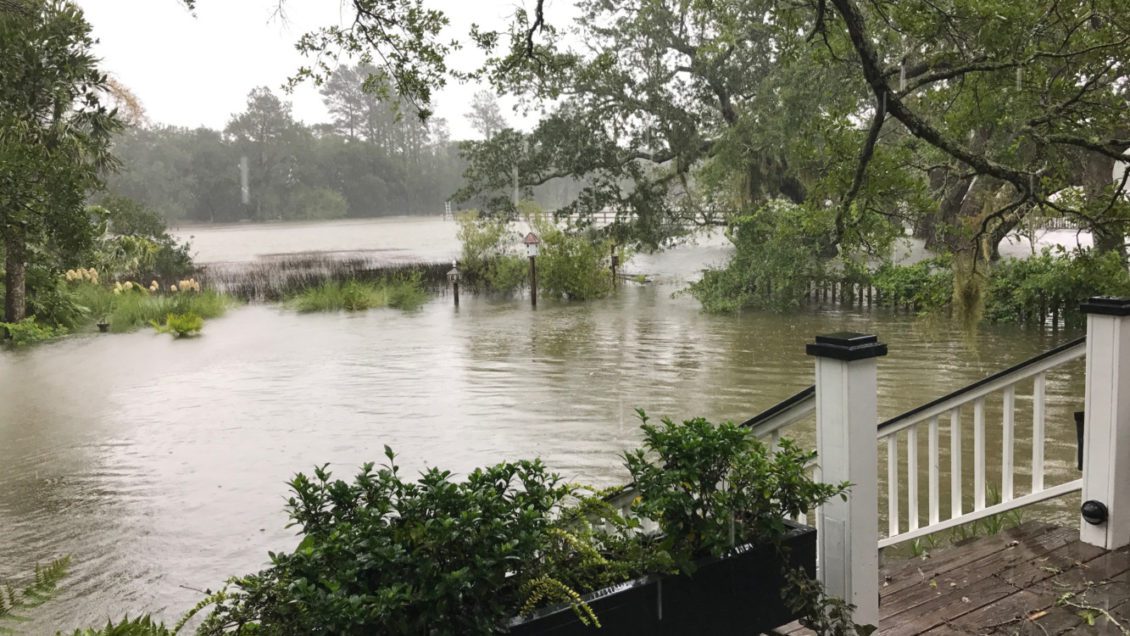CONWAY – Flood waters left behind by Hurricane Florence can have a devastating impact on homes and landscapes, but a Clemson environmental horticulturist says there is hope.

Gary Forrester, Clemson Cooperative Extension environmental horticulturist and master gardener coordinator in Horry County, said recovering a lawn after a flood can be challenging but it can be done.
“The recovery effort depends on the severity and the length of the flood event,” Forrester said. “Generally speaking, turfgrass species grown in the Carolinas can withstand a couple of days being covered with water without a significant loss of turfgrass quality. However, lawns inundated with water for more than several days can be impacted to the point where an entire stand can be lost.”
Forrester said to expect a significant loss of turf if a lawn has been covered with water for more than four days.
Damage to turf from flooding can be caused by several factors. The turf itself will have been impacted as sunlight needed by the plant to manufacture food has been reduced. The soil the turf is growing on can be impacted by soil particles settling out of the flood waters sealing the soil to water infiltration. Soil itself can be adversely impacted by a reduction of microbial activity, a reduction of soil drainage through the filling of pore spaces with fine soil particles, soil layering from flood water deposition and a possible acidity level (pH) change.
“There may have been pollutants in the water which could further impact the health of the turf,” Forrester said. “This includes water contaminated with petroleum products or pesticides, high water temperatures during the summer and eventually algae scum that can grow on saturated soils.”
High-valued turf areas that are at a risk of flooding should be protected, if possible, before any flood event. This can be accomplished by sandbagging around those areas to prevent flood waters from entering the areas. Also, soil berms can be built with sufficient height to keep a significant amount of water from intruding. If it appears the turf will be wet for an extended period of time, preventative fungicides should be applied to help reduce disease problems. The fungicides also should be applied once the water recedes to control diseases that will occur on the saturated turf.
In the event a lawn cannot be protected from flood waters, the following steps will help with recovering the lawn once flood waters have receded and lawn recovery can be safely done. These steps are:
- Pick up any lose debris that may be lying around on the lawn. This includes limbs, sticks, leaves, bottles or any other material that can pose a hazard when mowing.
- Remove deposited soil if it is more than 1 inch. More than 1 inch of deposited soil can cause significant turf loss unless it can be quickly removed. Be careful if using heavy equipment to remove deposited soil as this can cause significant soil compaction.
- Aerify the lawn using a core aerifier, a slicer or a verticutter. This opens the soil and allows for better internal drainage and air drying.
- Fungicide applications should be made to prevent turf loss to disease. If flooding occurs after September 1, avoid applying fertilizers containing nitrogen. Applying nitrogen late in the season could enhance winter kill as well as fueling disease problems. Applying a potassium fertilizer such as sulfate of potash will assist with plant recovery and disease resistance.
If an entire lawn is lost due to flooding, re-establishment or a lawn renovation will be needed. Renovating a lawn because of flooding will begin with the same process as outlined above. Remove any debris and deposited soil. Without knowing what contaminants may have been in the deposited soil, it is best to remove the soil if possible. Eliminate any drainage problems that may exist. Apply a soil activator to assist with microbial population and till the area as deep as possible to eliminate any soil layering. Once this is done, you can firm the new root bed and establish a new lawn through seeding, sodding or sprigging.
If sodding, do not place sod over dead vegetative material. Remove this material or thoroughly till it into existing soil. Sod should be placed on bare, well-prepared soils. Warm-season turfgrass can be planted April through September. If lawn renovations are done from October through March, a temporary lawn of ryegrass can be established to prevent erosion. The permanent lawn can then be established the following spring. Cool-season turfgrasses can be seeded October through April in regions where these grasses are adapted.
The deposition of seed weeds in another other complication resulting from flooded lawns. Flood water can carry a tremendous amount of weed seeds. Pre-emergent and post-emergent herbicides can be applied to help control weed infestations. However, getting a lawn established is the first priority to flood reclamation.
“Weed control measures should be the final step in lawn flood recovery and done only after the lawn has been re-established,” Forrester said.
For more emergency preparedness and post-hurricane impact resources, visit https://www.clemson.edu/public/emergency/hurricane/.
END
Get in touch and we will connect you with the author or another expert.
Or email us at news@clemson.edu

